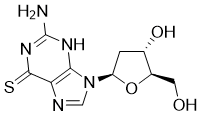| Description: |
6-Thio-2'-Deoxyguanosine is a nucleoside analogue that can be incorporated into de novo-synthesized telomeres by telomerase. |
| Target: |
DNA/RNA Synthesis[1] |
| In Vivo: |
In A549 lung cancer cell-based mouse xenograft studies, 6-Thio-2'-Deoxyguanosine causes a decrease of the tumor growth rate, superior to that observed with 6-thioguanine treatment. Additionally, 6-Thio-2'-Deoxyguanosine increases telomere dysfunction in tumor cells in vivo[1]. |
| In Vitro: |
Treatment with 6-Thio-2'-Deoxyguanosine results in rapid cell death for the vast majority of the cancer cell lines tested with IC50s of between 0.7-2.9 µM[1]. |
| Cell Assay: |
HCT116, A549, and H2882, HCC2429, HCC827, HCC15, H2087, HCC4017, HCC515, H2009, BJ and HCEC1 cells are plated in growth media in 96 well plates. Cells are incubated for 1 week and treated with varying concentrations of 6-Thio-2'-Deoxyguanosine and 6-thioguanine or DMSO every three days. The 96 well plates are analyzed for the CellTiterGlo luminescent cell viability assay[1]. |
| Animal Administration: |
Athymic NCR nu/nu female mice (6 weeks old) are used. A549 cells are inoculated subcutaneously into the left and right dorsal flanks of the nude mice in 100 µL phosphate buffered saline (PBS). When tumors reach 40 mm3 average volume, mice are randomly divided into control, 6-thio-dG and 6-thioguanine treatment groups (3 animals in each group). Animals are injected intraperitoneally every two days for 17 days at a dose of 2mg/kg in 100 µL DMSO/PBS mixture per mouse. In addition, different animals are injected intratumorally every day for 16 days at a dose of Athymic NCR nu/nu female mice2.5mg/kg in 50 µL DMSO/PBS mixture per mouse. Tumor size is measured by calipers and recorded either every day or every two days[1]. |
| References: |
[1]. Mender I, et al. Induction of telomere dysfunction mediated by the telomerase substrate precursor 6-thio-2'-deoxyguanosine. Cancer Discov. 2015 Jan;5(1):82-95. |






















